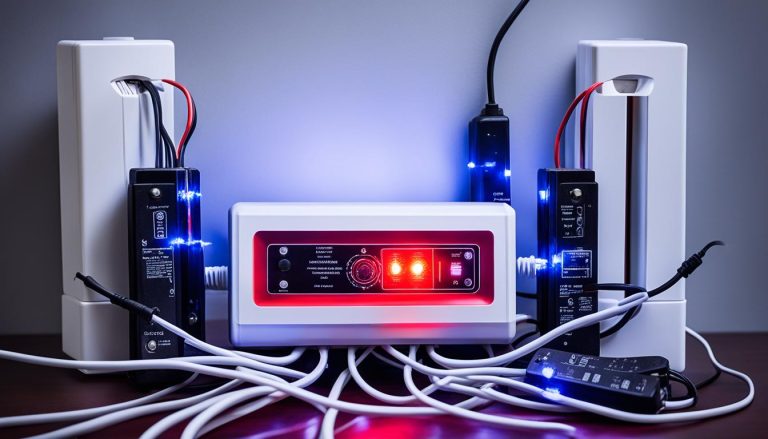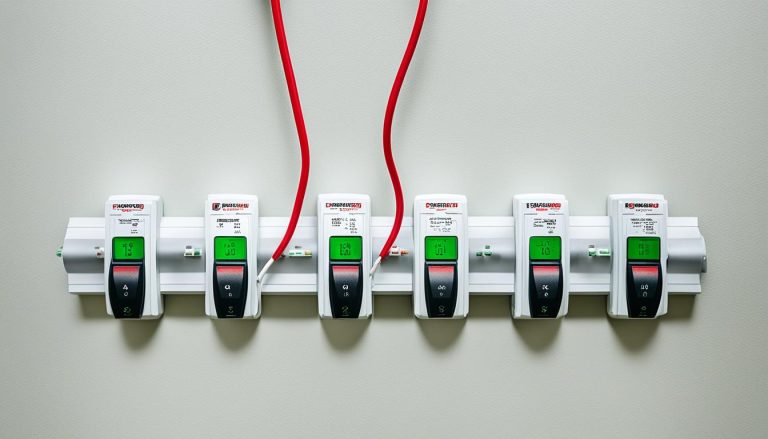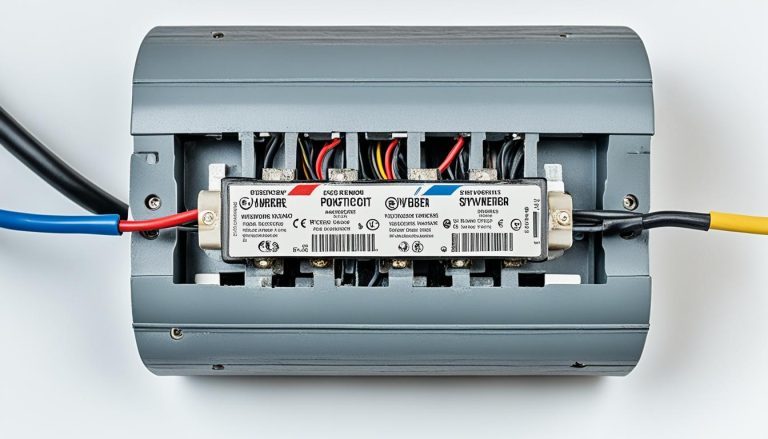Safe Surge Protector Use – Guard Your Electronics
extensioncords.site and its partners may earn a commission if you purchase a product through one of our links
A surge protector is an essential device that safeguards your valuable electronics from electrical surges. It provides protection by redirecting excessive electrical energy into the ground, shielding your devices from potential damage during power outages and voltage spikes. Ensuring safe surge protector use is crucial for maintaining the longevity and performance of your electronics. By following expert recommendations, you can maximize the effectiveness of your surge protector and keep your devices safe.
When considering surge protectors, it’s important to understand their features and safety guidelines. In this article, we’ll explore the dos and don’ts of surge protector safety, the difference between surge protectors and power strips, as well as the benefits of using a surge protector versus a UPS (uninterruptible power supply). Additionally, we’ll provide tips for using surge protectors and UPS to enhance safety precautions for your devices.
Key Takeaways
- Surge protectors safeguard your electronics from electrical surges and power outages.
- Follow the dos of surge protector safety to ensure optimal protection for your devices.
- Avoid the don’ts of surge protector safety to prevent hazards and potential damage.
- Understand the difference between power strips and surge protectors to make an informed buying decision.
- Consider a UPS in addition to surge protectors or power strips for backup power during outages.
The Dos of Surge Protector Safety
When it comes to ensuring the safety of your devices, surge protectors play a vital role. By protecting your electronics from power surges, surge protectors can extend their lifespan and prevent costly damage. To make the most of your surge protector and keep your devices safe, here are some important dos to keep in mind:
1. Do Choose the Right Surge Protector
Not all surge protectors are created equal. To ensure maximum protection for your devices, it’s essential to choose a surge protector that meets your specific needs. Consider factors such as the total joule rating, the number of outlets, and any additional features like USB ports or Ethernet protection. A surge protector buying guide can help you make an informed decision.
2. Do Plug Directly Into the Surge Protector
When connecting your devices, always plug them directly into the surge protector rather than using an extension cord or power strip. This ensures that the devices are directly protected by the surge protector’s circuitry, offering the highest level of safety.
3. Do Prioritize High-Value Electronics
If you have multiple devices, prioritize plugging in high-value electronics that are more susceptible to damage from power surges. This includes computers, televisions, gaming consoles, and other expensive equipment. By connecting these devices to the surge protector, you can safeguard your investments.
4. Do Regularly Inspect and Replace Surge Protectors
Surge protectors are not meant to last forever. Over time, the components inside them can degrade, reducing their effectiveness. Regularly inspect your surge protectors for any signs of wear or damage, and replace them as needed. This ensures that your devices are consistently protected.
5. Do Educate Yourself on Surge Protector Benefits
Understanding the benefits of surge protectors can help you appreciate their importance and make informed decisions. Surge protectors not only protect against power surges but also provide added convenience, with features like USB charging ports and cable management. By familiarizing yourself with the benefits, you can make the most of your surge protector.
Having learned about the dos of surge protector safety, it’s time to explore the don’ts of surge protector usage. By following these guidelines, you can ensure optimal protection for your valuable devices.
The Don’ts of Surge Protector Safety
While surge protectors are essential for safeguarding your electronics, it’s important to be aware of the don’ts to ensure their effective and long-lasting use. By avoiding these common mistakes, you can maximize the protection provided by your surge protector:
Don’t overload your surge protector
One of the key don’ts of surge protector safety is overloading. Each surge protector has a maximum load capacity specified in its specifications. Exceeding this limit can result in overheating and damage to both the surge protector and your connected devices. Be sure to check the surge protector specifications to determine the maximum load it can handle and avoid plugging in devices that exceed this limit.
Don’t daisy chain surge protectors
It can be tempting to connect multiple surge protectors in a series to accommodate all your electronic devices. However, daisy chaining surge protectors is a hazardous practice that increases the risk of electrical overloads and can compromise the effectiveness of surge protection. Instead, use a single surge protector with an adequate number of outlets or consider using a power strip or a different surge protector with a higher outlet count.
Don’t expose surge protectors to hazards
In order to prevent electrical hazards and ensure optimal surge protector performance, avoid exposing surge protectors to potentially damaging conditions. Keep surge protectors away from water sources such as sinks, baths, and bathrooms. Similarly, avoid placing surge protectors in areas prone to excessive heat or direct sunlight. Excessive moisture and heat can compromise the safety and functionality of surge protectors, making them less effective in guarding your valuable electronics.
Don’t neglect surge protector maintenance
Regular maintenance is crucial to ensure the ongoing effectiveness of surge protectors. Periodically inspect your surge protector for any signs of physical damage, such as frayed cords or broken sockets, and replace them immediately if found. Additionally, clean the surge protector regularly to remove any dust or debris that may accumulate on its surface. By taking these maintenance steps, you can extend the lifespan of your surge protector and maintain its performance.
Follow these don’ts of surge protector safety to enhance the protection provided by your surge protector and safeguard your valuable electronics from electrical surges.
Surge Protector Maintenance Checklist
| Maintenance Step | Frequency |
|---|---|
| Inspect surge protector for physical damage | Every 6 months |
| Clean surge protector surface | Every 3 months |
| Replace damaged cords or sockets | Immediately if found |

The Difference Between Power Strips and Surge Protectors
If you’ve ever walked into an electronics store, you’ve probably come across power strips and surge protectors. While they may appear similar at first glance, it’s essential to understand the key differences between these two devices. Let’s explore the distinctions and determine when to choose a power strip or a surge protector.
Power strips are designed to provide additional outlets for your devices. They come in various lengths and configurations, allowing you to connect multiple electronics to a single power source. However, it’s important to note that not all power strips offer surge protection.
Surge protectors, on the other hand, go a step further by safeguarding your electronics against power surges. These surges, which can occur during electrical storms or power outages, can damage or destroy your devices. Surge protectors work by diverting excess electrical energy into the ground, protecting your valuable electronics from harm.
So, why choose a surge protector over a power strip? Well, if you want to ensure the safety and longevity of your electronic devices, a surge protector is a wise investment. By providing both extra outlets and surge protection, it offers comprehensive protection for your electronic equipment.
Before purchasing a power strip or a surge protector, it’s crucial to read the product specifications carefully. Look for the distinction between a basic power strip and a surge protector with built-in surge protection capabilities. This way, you can make an informed decision and select the right device for your needs.
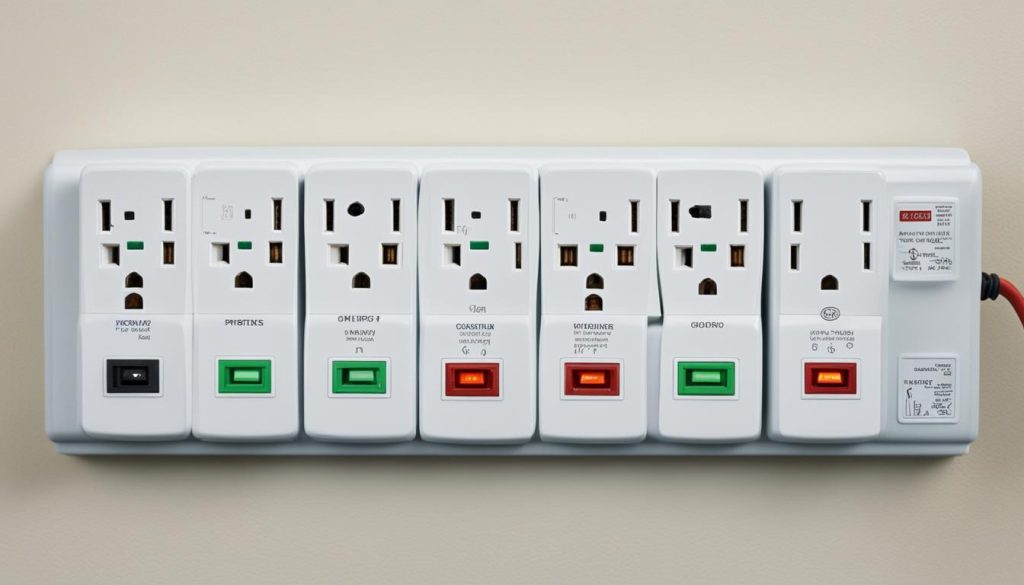
Power Strip vs. Surge Protector: A Comparison
Let’s compare power strips and surge protectors side by side to understand their similarities and differences:
| Power Strip | Surge Protector |
|---|---|
| Provides extra outlets | Provides extra outlets |
| May or may not have surge protection | Offers surge protection |
| Does not protect against power surges | Protects against power surges |
| May be suitable for basic electrical needs | Ideal for protecting sensitive electronic devices |
Surge Protectors, Power Strips, and UPS – Which One Do You Need?
When it comes to protecting your electronics, surge protectors, power strips, and UPS (uninterruptible power supply) devices all have unique benefits. Depending on your specific needs, you may find one of these options more suitable than the others.
A surge protector is designed to safeguard your devices from sudden spikes in voltage caused by power surges. It diverts excess electrical energy into the ground, preventing damage to your valuable electronics. Surge protectors are essential for protecting sensitive devices like computers, televisions, gaming consoles, and audio equipment. They offer peace of mind and ensure your devices have a longer lifespan.
Power strips, on the other hand, primarily provide additional outlets for your devices. Some power strips also offer surge protection, but it’s important to check the specifications to ensure proper surge protection. Power strips are useful for situations where you need to connect multiple devices or appliances to a single power source.
If you’re looking for more comprehensive protection during power outages, a UPS might be the right choice for you. A UPS not only offers surge protection but also provides temporary backup power. This is particularly important for critical work, protecting against data loss, or sustaining power to devices that need uninterrupted operation, such as servers or medical equipment.
When to Use a UPS
Consider using a UPS in the following scenarios:
- You need to protect your work in progress and prevent data loss during power outages.
- You have critical devices or equipment that cannot tolerate even a short interruption in power supply.
- You live in an area with frequent power fluctuations, blackouts, or storms that could disrupt your power supply.
Comparison: Surge Protectors, Power Strips, and UPS
| Device | Benefits | Best Suited For |
|---|---|---|
| Surge Protector | Protects devices from power surges Provides peace of mind and device longevity |
Sensitive electronics, such as computers, TVs, and gaming consoles |
| Power Strip | Offers additional outlets Some models provide surge protection |
Situations requiring multiple device connections |
| UPS (Uninterruptible Power Supply) | Provides surge protection and temporary backup power during outages | Critical work, protecting against data loss, and uninterrupted operation of devices |
Ultimately, the choice between surge protectors, power strips, and UPS devices depends on your specific needs and the devices you want to protect. While surge protectors and power strips are often sufficient for most home electronics, a UPS offers an extra layer of protection and uninterrupted power supply for critical devices and work. Consider your requirements and select the option that fits best.
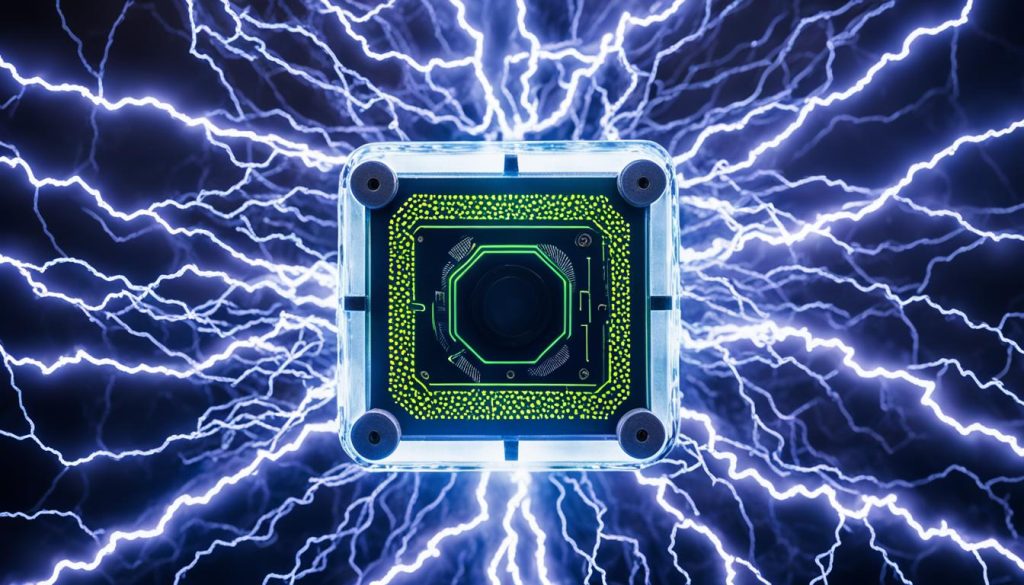
Tips for Using Surge Protectors and UPS
When it comes to protecting your valuable electronic devices, surge protectors and Uninterruptible Power Supplies (UPS) play a crucial role. Here are some essential tips to ensure optimal safety:
1. Choose the Right Surge Protector
Not all surge protectors are created equal. Make sure to select a surge protector that is suitable for your specific needs. Consider factors such as the number of outlets, joule rating, and response time. Read user reviews and ratings to ensure you’re getting a reliable surge protector that meets your requirements.
2. Follow Surge Protector Installation Guidelines
Proper installation is key to maximizing the effectiveness of your surge protector. Plug it directly into a properly grounded wall outlet—avoid using extension cords or power strips. Avoid daisy-chaining surge protectors or plugging high-power devices, such as refrigerators or air conditioners, into the same surge protector. This can overload the surge protector and reduce its ability to protect your devices.
3. Understand the Limitations of Surge Protectors
While surge protectors are designed to protect against sudden voltage spikes, they cannot provide continuous power during extended outages. If you require uninterrupted power supply, consider using a UPS in conjunction with a surge protector. A UPS provides temporary backup battery power to keep your devices running during power failures, giving you enough time to save your work and safely shut down your equipment.
4. Regularly Inspect and Maintain Your Surge Protectors and UPS
Inspect your surge protectors and UPS regularly for any signs of wear, damage, or loose connections. Replace them if you notice any issues. Keep them in a well-ventilated area and avoid placing them near heat sources. In the case of a UPS, check the battery status periodically and replace the battery as recommended by the manufacturer.
By following these surge protector tips and UPS safety tips, you can safeguard your electronic devices and enjoy peace of mind, knowing they are protected from harmful power surges and outages.
FAQ
What is a surge protector and how does it work?
A surge protector is a crucial piece of equipment that protects your devices from electrical surges. It works by redirecting excess electrical energy into the ground, protecting your devices from damage during power outages.
What are the dos of surge protector safety?
To ensure safe surge protector use, follow these expert recommendations:
– Do use a surge protector for all your electronic devices.
– Do choose a surge protector with a high joule rating.
– Do plug your surge protector directly into a grounded wall outlet.
– Do inspect your surge protector regularly for any signs of damage or wear.
What are the don’ts of surge protector safety?
To ensure safe surge protector use, here are some things you should avoid:
– Don’t overload your surge protector with too many devices.
– Don’t daisy-chain surge protectors together.
– Don’t use surge protectors in wet or humid environments.
– Don’t cover or block the vents of your surge protector.
What is the difference between power strips and surge protectors?
Power strips provide extra outlets, while surge protectors offer protection against power surges. Power strips may or may not have surge protection built-in, so it’s essential to choose a surge protector when you need both extra outlets and surge protection.
Do I need both a surge protector and a UPS?
Depending on your needs, you may also consider a UPS (uninterruptible power supply) in addition to a surge protector or power strip. A UPS provides temporary backup power during outages and is particularly useful if you need to protect your work or prevent data loss. However, surge protectors and power strips offer sufficient protection for most devices.
Are there any tips for using surge protectors and UPS?
Yes, here are some tips for optimal safety when using surge protectors and UPS:
– Do not plug appliances with high power demands into surge protectors.
– Do not use extension cords with surge protectors or UPS.
– Do perform regular inspections of your surge protectors and UPS to ensure they are functioning properly.
– Do follow the manufacturer’s instructions for installation and maintenance.


